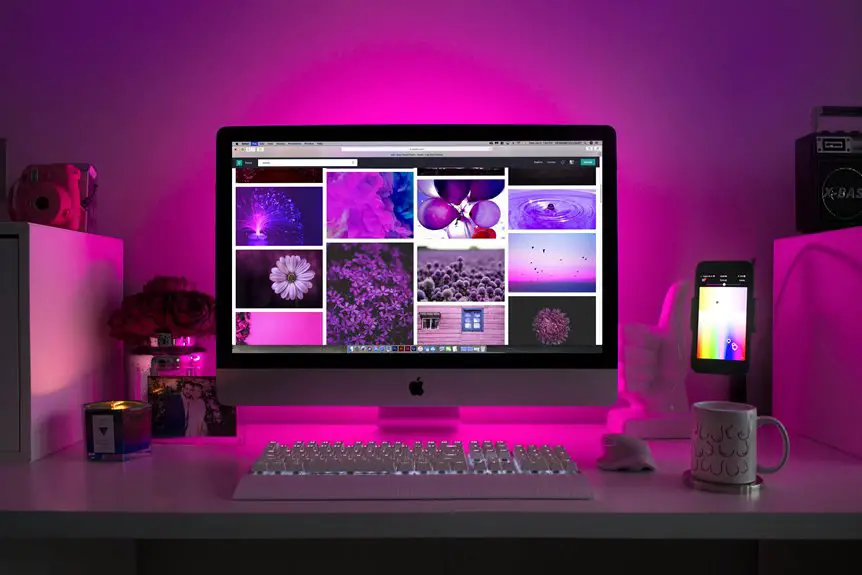When it comes to choosing the right monitor for digital art, you need to consider several critical factors. Color accuracy and a broad color gamut are essential for achieving true-to-life hues in your work. You'll also want to think about resolution and screen size, as these can significantly impact your design process. But that's just the beginning; there are other important aspects to explore that can enhance your creative experience.
Table of Contents
Key Takeaways
- Prioritize color accuracy by choosing monitors that cover Adobe RGB or DCI-P3 gamuts for true color representation in your artwork.
- Opt for higher resolution and larger screen sizes to maintain detail and provide ample workspace for intricate designs.
- Select IPS panels for superior color accuracy and viewing angles, while considering your budget and specific needs.
- Ensure the monitor has multiple connectivity options like HDMI and USB-C for seamless compatibility with your devices.
- Keep ergonomics in mind with adjustable stands to reduce neck and eye strain during long working sessions.
Understanding Color Accuracy and Gamut
How crucial is color accuracy when it comes to digital art? It's everything. You want your colors to pop and reflect your vision accurately.
When you're creating, you need a monitor that shows true colors, allowing you to make adjustments that resonate in the final artwork. If your monitor has a limited gamut, you're likely to miss out on vibrant tones and subtle shades.
Look for monitors with high color accuracy ratings, like those that cover Adobe RGB or DCI-P3 gamuts. These specifications ensure your work translates well across different platforms.
Investing in a reliable monitor helps you maintain consistency in your art, ultimately enhancing your creative process and ensuring your audience sees your work as intended.
The Importance of Resolution and Screen Size
When creating digital art, resolution and screen size play a pivotal role in how you experience and execute your vision. A higher resolution provides greater detail, allowing you to work on intricate designs without losing clarity. When you zoom in, every brushstroke remains sharp, which is essential for precision work.
Screen size also matters; a larger display gives you more workspace, letting you see your entire project at once. This can enhance your workflow by reducing the need to constantly zoom in and out.
However, balance is key—too large of a monitor might strain your eyes if you're too close. Aim for a resolution that complements your screen size, ensuring you achieve the best possible results in your digital art.
Choosing the Right Panel Type
Selecting the right panel type is crucial for optimizing your digital art experience. When choosing a monitor, consider IPS, VA, and TN panels.
IPS panels offer excellent color accuracy and wider viewing angles, making them a favorite among artists. If you're working with vibrant colors and need precision, this might be your best bet.
VA panels provide better contrast and deeper blacks, ideal for certain styles but may lack in color fidelity.
TN panels are typically faster and cheaper, but they struggle with color reproduction and viewing angles, which can be limiting for detailed work.
Think about your specific needs, such as color accuracy, response time, and budget, to determine which panel type suits your artistic workflow best.
Connectivity Options and Ergonomics
While you may find the perfect panel type for your digital art, having the right connectivity options and ergonomic features is equally important.
Look for monitors with multiple ports like HDMI, DisplayPort, and USB-C, ensuring compatibility with your devices. You want seamless connections for your graphic tablet or laptop, so don't overlook these options.
Ergonomics also play a crucial role in your comfort. Adjustable stands that allow you to tilt, swivel, or heighten the monitor are essential for reducing neck and eye strain during long hours of work.
Consider models with VESA mount compatibility if you prefer a more customized setup. Balancing connectivity and ergonomics will enhance your digital art experience significantly.
Setting a Budget for Your Monitor Selection
After ensuring your monitor has the right connectivity options and ergonomic features, it's time to consider your budget.
Start by determining how much you're willing to spend. Monitors for digital art can range from a few hundred to several thousand dollars, so narrowing your budget helps focus your options.
Think about what features are essential for your work—like color accuracy and resolution—and weigh them against your budget. If you're just starting, you might choose a more affordable option with decent specifications.
However, if you're a seasoned artist, investing in a higher-end model could enhance your workflow.
Frequently Asked Questions
What Aspect Ratio Is Best for Digital Art Monitors?
You'll find that a 16:9 aspect ratio is popular for digital art, offering a good balance between width and height. However, 16:10 provides extra vertical space, which can be beneficial for detailed work.
How Does Refresh Rate Impact Digital Art Creation?
Refresh rate affects how smoothly your artwork appears on-screen. A higher refresh rate reduces lag, making your brush strokes feel more responsive. You'll notice a difference, especially during animations or real-time editing. Your creativity thrives with smoother visuals.
Are Matte or Glossy Screens Better for Artists?
When deciding between matte or glossy screens, you'll find matte reduces glare and reflections, making it easier to work in bright environments. Glossy, however, offers more vibrant colors, enhancing your overall viewing experience. Choose based on your preferences.
Can I Use a TV as a Monitor for Digital Art?
Yes, you can use a TV as a monitor for digital art, but it might not offer the color accuracy and resolution you need. Consider factors like input lag and screen size before making your choice.
How Often Should I Calibrate My Monitor for Accurate Colors?
You should calibrate your monitor every month or whenever you notice color shifts. Regular calibration ensures your colors stay accurate, helping you maintain consistency in your work and achieve the best results in your projects.




